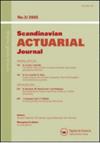损失严重程度的相位型专家混合回归
IF 1.4
3区 经济学
Q3 MATHEMATICS, INTERDISCIPLINARY APPLICATIONS
引用次数: 8
摘要
当数据与经典回归假设不一致时,解决索赔严重程度建模的任务。这个框架在保险和再保险的几个业务线中很常见,在这些业务线中,灾难性的损失或异构的子群体导致数据难以建模。他们的正确分析是为保险产品定价所必需的,在这个方向上最流行的一些规范是专家混合模型。本文提出了一种将后一种方法推广到相型分布设置的回归模型。更具体地说,混合的概念被扩展到整个马尔可夫跳跃过程是不可观察的,并且状态可以相互通信的情况。然后,协变量作用于这种底层链的初始概率,它起着专家权重的作用。用矩阵泛函的形式计算了该模型的基本性质,并推导了密度性质,显示了其灵活性。提出了一种基于EM算法和多项逻辑回归的有效估计方法,并利用模拟和实际数据集进行了说明。所提出的模型增加的灵活性并不需要很高的计算成本,并且动机和解释对于更简单的MoE模型同样透明。本文章由计算机程序翻译,如有差异,请以英文原文为准。
Phase-type mixture-of-experts regression for loss severities
ABSTRACT The task of modeling claim severities is addressed when data is not consistent with the classical regression assumptions. This framework is common in several lines of business within insurance and reinsurance, where catastrophic losses or heterogeneous sub-populations result in data difficult to model. Their correct analysis is required for pricing insurance products, and some of the most prevalent recent specifications in this direction are mixture-of-experts models. This paper proposes a regression model that generalizes the latter approach to the phase-type distribution setting. More specifically, the concept of mixing is extended to the case where an entire Markov jump process is unobserved and where states can communicate with each other. The covariates then act on the initial probabilities of such underlying chain, which play the role of expert weights. The basic properties of such a model are computed in terms of matrix functionals, and denseness properties are derived, demonstrating their flexibility. An effective estimation procedure is proposed, based on the EM algorithm and multinomial logistic regression, and subsequently illustrated using simulated and real-world datasets. The increased flexibility of the proposed models does not come at a high computational cost, and the motivation and interpretation are equally transparent to simpler MoE models.
求助全文
通过发布文献求助,成功后即可免费获取论文全文。
去求助
来源期刊

Scandinavian Actuarial Journal
MATHEMATICS, INTERDISCIPLINARY APPLICATIONS-STATISTICS & PROBABILITY
CiteScore
3.30
自引率
11.10%
发文量
38
审稿时长
>12 weeks
期刊介绍:
Scandinavian Actuarial Journal is a journal for actuarial sciences that deals, in theory and application, with mathematical methods for insurance and related matters.
The bounds of actuarial mathematics are determined by the area of application rather than by uniformity of methods and techniques. Therefore, a paper of interest to Scandinavian Actuarial Journal may have its theoretical basis in probability theory, statistics, operations research, numerical analysis, computer science, demography, mathematical economics, or any other area of applied mathematics; the main criterion is that the paper should be of specific relevance to actuarial applications.
 求助内容:
求助内容: 应助结果提醒方式:
应助结果提醒方式:


